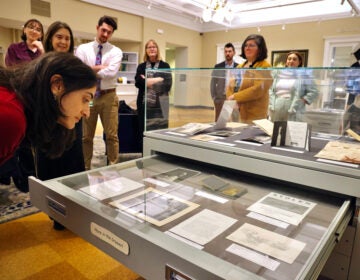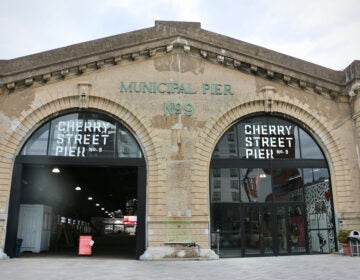Cherry Street Pier opens its largest public art exhibition since pandemic began
An exhibition of artwork by recent MFA graduates experiments with sound, video, performance, and sculpture to engage the public during a pandemic.
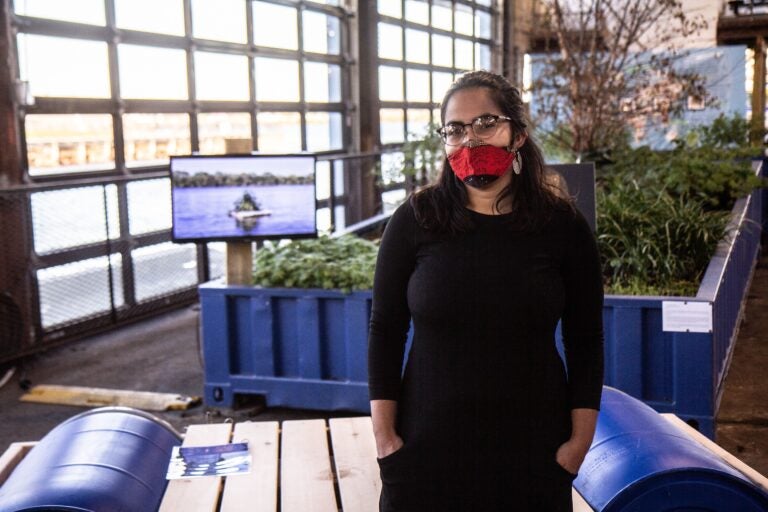
Artist Ana Mosquera with her work “Deception Island” at Testing Grounds at the Cherry Street Pier. (Kimberly Paynter/WHYY)
The Cherry Street Pier on Philadelphia’s waterfront is opening its largest art show since shutting down in March, featuring work by 20 artists across many disciplines, some of which hide in plain sight.
The pier has been slowly reintroducing cultural events over the last few months, carefully managing the number of people allowed inside to abide by pandemic guidelines. It has hosted relatively small art markets and a photo exhibition.
The pier has its own community of resident artists with studios made from converted shipping containers. The artists have been allowed to access those studios since June.
This weekend it opens “Testing Grounds”, which was first conceived in the summer of 2019 as a show for students completing their MFA degrees in Philadelphia art schools. Co-curator Austen Camille, herself a recent MFA graduate from Temple University’s Tyler School of Art and Architecture, wanted to give artists a chance to make work for a public space.
“It’s important to push art out of white cube gallery space, have it be more accessible, less pretentious,” Camille said.
Over the last year the show was postponed twice: once last October due to roofing repairs at the pier, then again in March because of the pandemic. Over that time, the artists have been creating work responding to the moment.
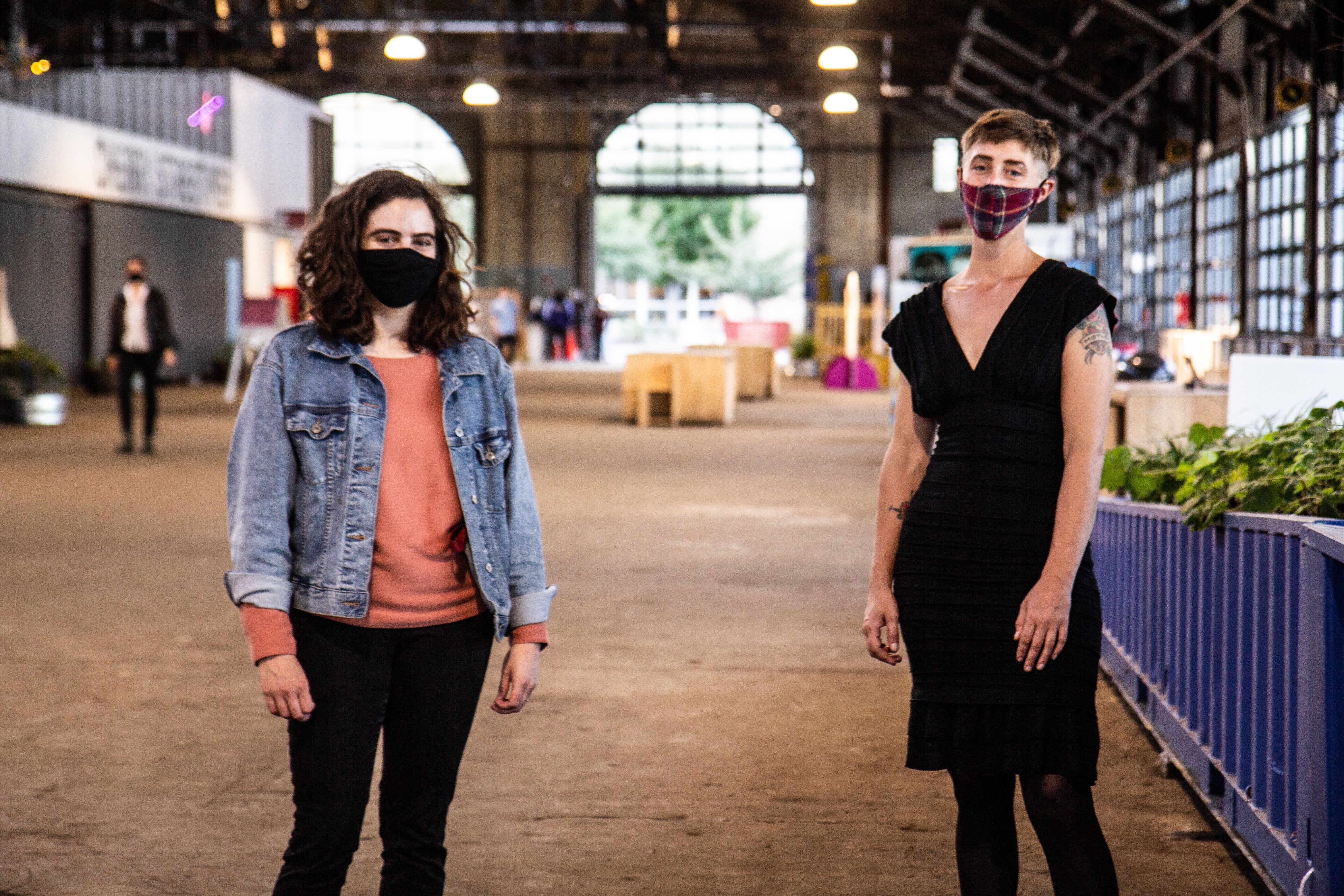
Sneaky monotone messages
The show includes socially-distanced performances, a guided walking tour, a small gallery of paintings, video art, and a sound installation that can be easily missed if you’re not paying attention. Artist Jazmyn Crosby recorded herself making monotone public address announcements that have been incorporated into Cherry Street Pier’s PA system, softly playing familiar pop songs.
“I like to make my voice sound like Siri or the airport lady,” said Crosby, a recent Tyler MFA graduate. “I’m really interested in pranks.”
Her audio messages are surreal, sometimes reciting long lists of seemingly random numbers, lost and found announcements for an email or a Styrofoam cup, and instructions on how to alter your own perception of your immediate environment.
“Begin by examining both or your pointer fingers,” she recites in an audio message playing from the ceiling speakers of Cherry Street Pier between songs. “Hold both fingers up to your face and pull them away until the blur of the room becomes vivid again.”
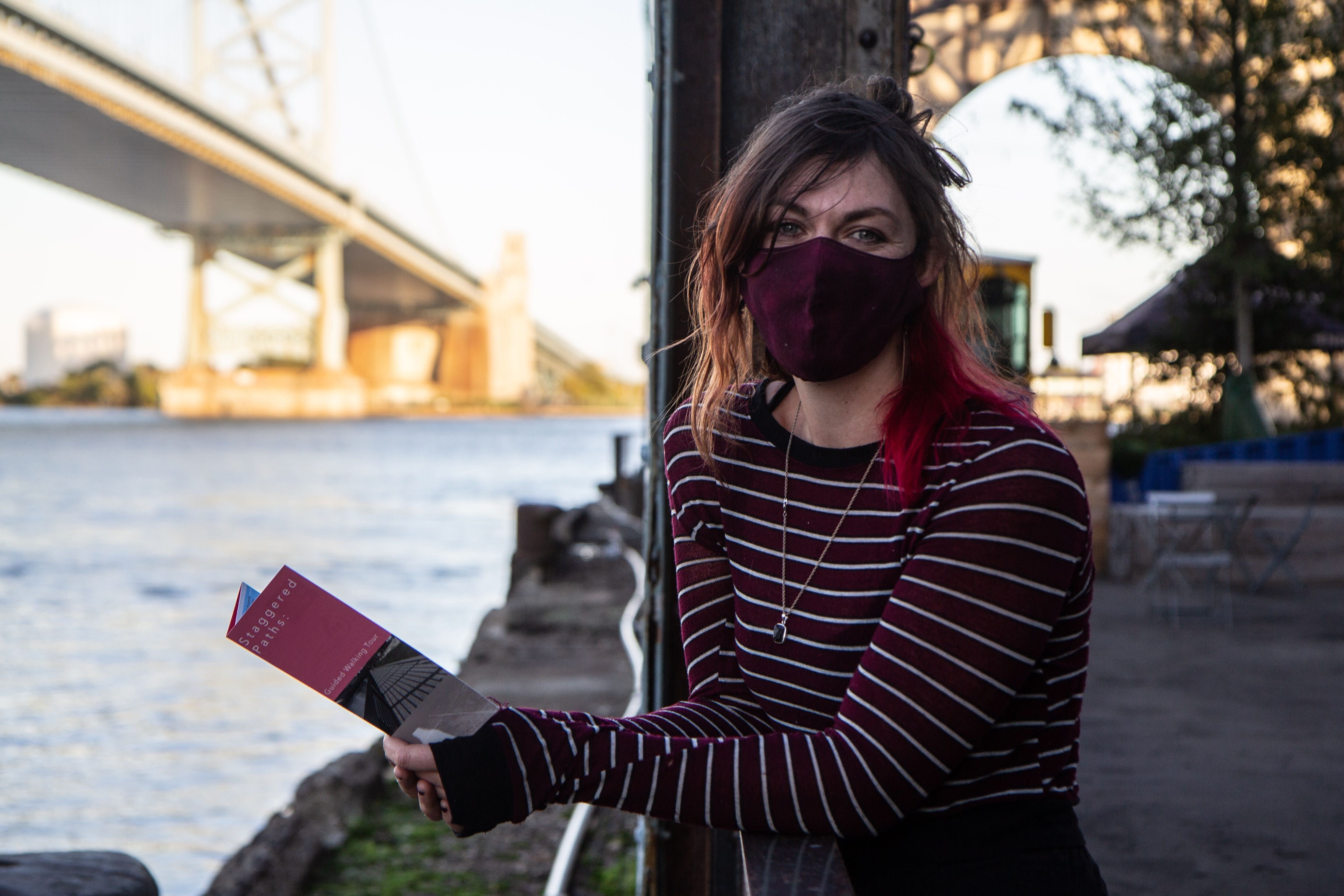
Crosby’s grad school work had been focused primarily on the flaws of modern communication and the inability to be precisely understood, mining the glitches and misinterpretations inherent in technology. Her work seemed to have become prescient as the pandemic hit and many nonessential jobs moved to Zoom.
Sneaking her audio messages into a public space where people’s attention is often drawn elsewhere – most prominently the open water and sky – adds another layer of complexity to Crosby’s work.
“Grad school can feel a bit like a bubble. You spend so much time talking about your work with a small group of people, which is a really safe space to try things out. But it kind of stays in that bubble,” she said. “It’s such an exciting opportunity to share that work with a real public audience.”
Deception Island
Another piece in the show is a video monitor showing a small artificial island, about the size of a pizza box, floating on the Delaware River in front of Petty Island, a former oil storage facility for the Venezuelan-owned company Citgo now being converted into a nature preserve by the state of New Jersey.
What seems at first to be a meditative piece of a simple video clip of a river set against a backdrop of the actual river, is revealed to be a Kafkaesque nightmare once you pick up the accompanying pamphlet. By scanning a QR code, you are sent to the website of the fictional nation of “Deception Island.” To enter the nation you need to temporarily renounce your current citizenship, lease it to the island, and then rent a Deception Island citizenship.
The catch is, once you let go of your citizenship the website sends you into a loop, never enabling you to gain island citizenship. You are rendered stateless.
“I had to give this nation an economy,” said artist Ana Mosquera. “What drives the economy of this little nation is collecting the data that all the users are going to be leaving behind as they lease their citizenship.”
Mosquera is from Venezuela and came to Philadelphia on a student visa to study at Temple University. However, since she arrived, diplomatic relations between the U.S. and Venezuela have broken down over the disputed election of Nicolás Maduro in 2018. As a result, Venezuela has closed its embassy in Washington D.C.
Now Mosquera cannot renew her passport, which expired two years ago, causing constant problems with any bureaucratic transaction that requires an official form of identification.
“Deception Island” is rooted in the artist’s frustrating experience of being caught up in international politics.
“I thought the government of Venezuela would protect me,” said Mosquera. “But, no, they have abandoned me here.”
The artists in “Testing Grounds” had to rethink how to present their work to accommodate both COVID-19 restrictions and the layout of Cherry Street Pier. Although it is huge, with 65,000 square feet, the pier is not conducive to traditional art presentation. For example, there are few walls on which to hang art, the space dominated by large glass panes looking out over the river. Sculpture and other three-dimensional works have to be moveable, so that the pier can reconfigure itself to accommodate other programming.
Surya Swilley will perform a movement-based work in a hallway in a second-tier walkway, with individual audience members spaced apart from each other. Another pair of artists, Julia Gladstone and Emmanuela Soria Ruiz, will perform on a stage set up in a large, open window facing Race Street Pier; audiences will be able to watch from the opposite pier, about 100 feet away across a body of water.
All of the performances are free, but tickets are required to limit audience sizes. The exhibition also features a map, pointing out artwork that might be missed or difficult to recognize.
Several artists will show video work on a large monitor suspended from the 50-foot ceiling. While the imagery alone, without sound, will be on a constant loop throughout the day, the full audio and video experience will be shown on a schedule.
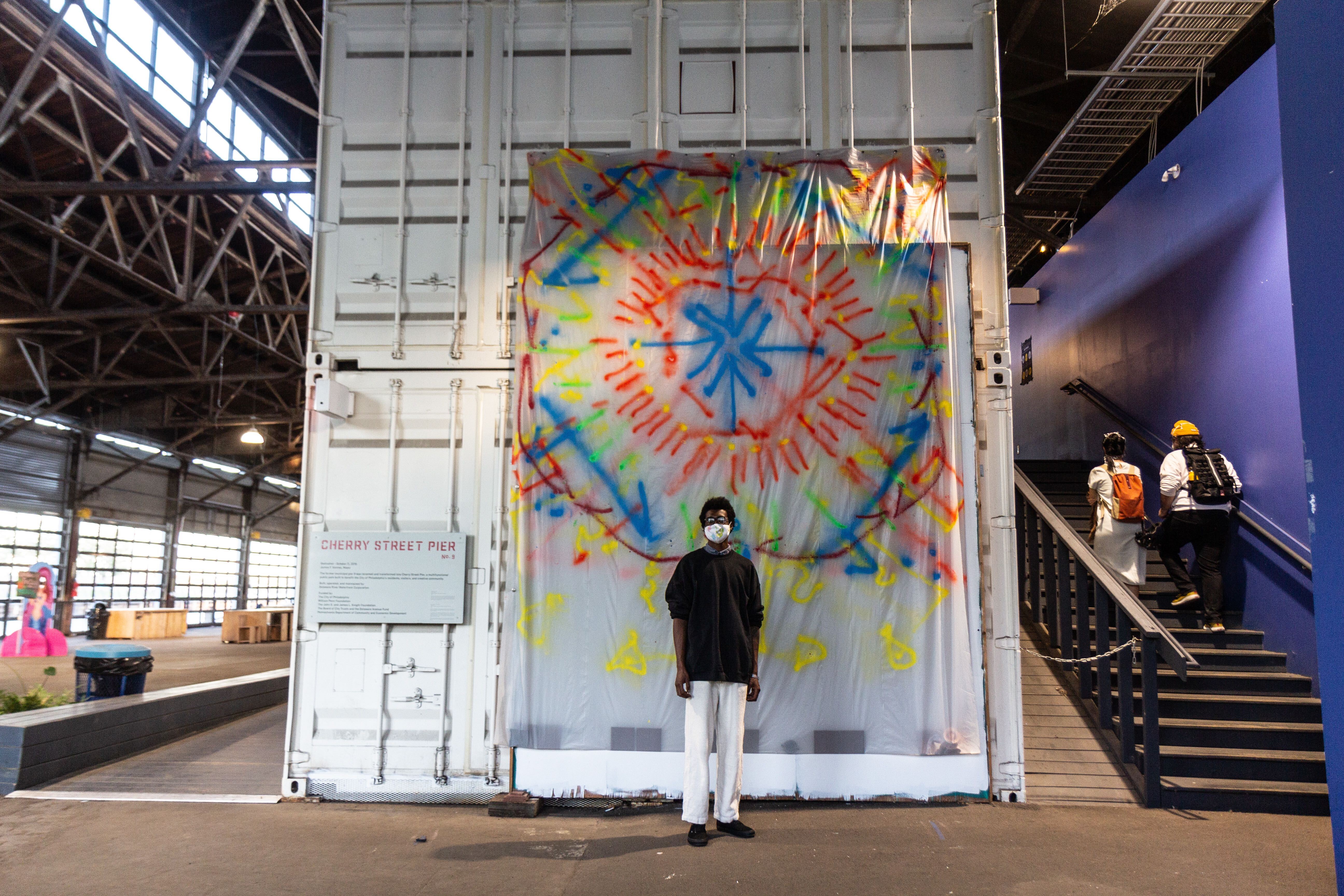
Neon coming in November
“Testing Grounds” will not be the only installation at Cherry Street Pier this fall. A major show by neon light sculptor John Schlesinger is now being prepared for an expected November opening.
Since it shut down in March, the Delaware River Waterfront Corporation, which runs Cherry Street Pier, has been reaching out to regional arts and culture organizations to offer the pier as a usable space. Creative director Emma Fried-Cassorla realized that, during a pandemic when many spaces were forced to close, the pier offers a unique setting of both indoor and outdoor spaces. People can be distanced, outside, and somewhat protected from the elements.
“We recognized that everyone has been hit by the pandemic and space is at a premium,” said Fried-Cassorla. “We have so much outdoor space. We are finding ways to partner with nonprofits.”
She offered an example of BalletX, the modern dance company that has been bringing its dancers to the pier for rehearsals. Fried-Cassorla said the space is also appropriate for children’s dance recitals, music rehearsals, and workshops for yoga and meditation.
She stressed that pier can be used for unannounced rehearsals and practices but not for public performances, in accordance with COVID-19 audience restrictions.
“We’re more interested in making sure that community can sustain however it can,” said Fried-Cassorla. “It’s an unintended benefit for us that the waterfront is active. Maybe you’ll see BalletX rehearse and it looks like a performance. But the guidelines are very strict about gatherings.”
Cherry Street Pier currently allows 250 people inside its space, per city guidelines.


Get daily updates from WHYY News!
WHYY is your source for fact-based, in-depth journalism and information. As a nonprofit organization, we rely on financial support from readers like you. Please give today.



